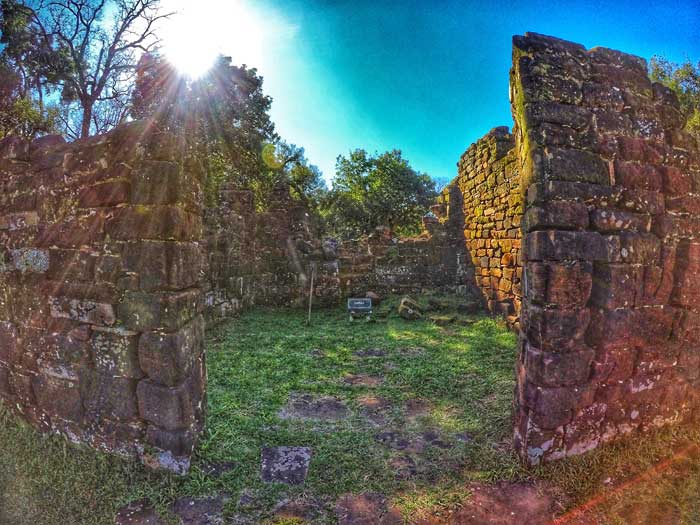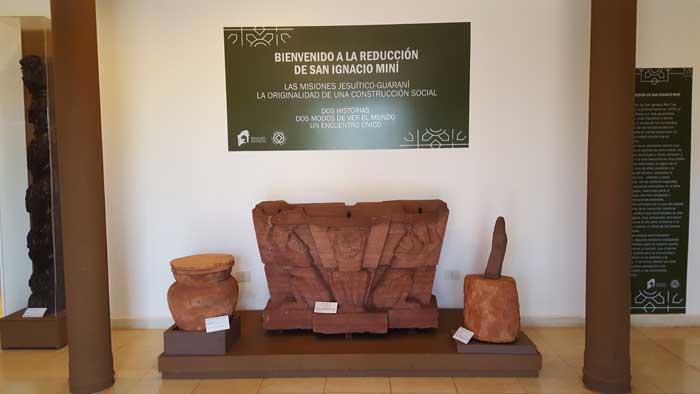I walked to the side of the ruins to avoid the huge group of middle-aged tourists strolling to the entrance of the church.
At this area, and to the back of the ruins, I was alone.
No matter how damaged they are, these sharp, edged red sandstone structures look photogenic from every angle. I had my own mini-photoshoot. No photobombers, no weird stares, just me and my trusty Gopro.


When I returned to the front of the ruins, the tour group was gone. I had the whole place to myself. This is a UNESCO site on a winter afternoon. It doesn’t make sense to have an off-season because it felt like summer here in Northern Argentina.
For the first time in almost 3 months, I wasn’t wearing my jacket and *gasps* I was finally sweating.
The sun was beaming strong in San Ignacio, a small town 56km northeast of Posadas, capital of Misiones Province. This unique town feels different from the rest of Argentina.
Inhabitants have darker skin, more akin to the native Indians of the north. Homeless, dirt-covered and barefoot children surround the main attraction: the ruins of San Ignacio Mini, located right smack in the middle of town.
These ruins are the only reason I came.

For a normal person, San Ignacio would be a stopover en route to the famous Iguazu Falls. But for me, if it has an interesting historical significance AND is a UNESCO heritage site, I’d find my way there.
And interesting it was.
Constructed in the seventeenth century, the San Ignacio Mini is one of thirty or so Jesuit Mission complex in the rainforest area between Argentina, Brazil and Paraguay.
What made it interesting is that these ruins were one of the few perfect examples of culture synthesis between the white European colonists and the native Guarani people.
With the aim of converting the Guarani to their mission, unlike other colonists, the Jesuits did not supress their primitive culture. Instead they actively contributed to the Guarani way of life by introducing new customs, social organization and of course, teaching the Gospels.


This resulted in a union of cultures without violent conflicts, which flourished till the 1750s. The Jesuits protected the Guarani culture, suppled spiritual texts and other works in Guarani language, and encouraged activities in the different languages. The Mission also sheltered the people from the menacing Portuguese slave traders and the ongoing war.
As I walked along the remnants of a once thriving community, I tried to imagine how life was like in the core of the mission back in the days. There was a main plaza, a hospital, a school, a farm, a cabildo where the Guarani chief lived and of course, a magnificent stone church.
In the Spanish baroque style architecture, Guarani influence can be seen in the many indigenous motifs carved on the walls and lintels: silhouettes of angels, doves and humans and elegantly entwined fruits and plants.

At its peak, San Ignacio had 4000 dwellers. It thrived till the Guarani War in 1750s and abandoned after the expulsion of the Jesuits in 1767, due to envy, resentment and paranoia by the Spanish Crown.
It was only rediscovered in the 1940s. Over the centuries, there were multiple collapses. The roofs of the buildings were gone but the massive disconnected walls and arches still stand. Erosion by natural elements threatened further damage. In fact, the ruins were closed to the public in the early 1990s due to structural instability.
watch a 1min highlight of the experience here
Even in this ruined state, the moss covered red sandstone architecture complex still is impressive. Although it doesn’t look like much, San Ignacio Mini features one of the best restorative conditions out of all the other reductions in the Jesuit Order.
After obtaining UNESCO heritage site status in 1984 together with the nearby ruins of Loreto and Santa Ana, there is now a hint of modernity which, in my opinion, distracts from the authenticity of the area; like the huge multi-lingual audio guides stationed throughout the ruins and the dozens of lights planted for the nightly light and sound show.

The audio guides
A very small museum stands at the entrance, containing artefacts and stone carvings from the Jesuit missions. Outside, the roads surrounding the ruins are lined with eyesore souvenir stands, cafes and tour buses.

The Museum
An entrance ticket costs ARS $200 (June 2017) and includes entry to the Loreto and Santa Ana ruins. The nightly light and sound show costs an additional ARS $200. I skipped it because it was too expensive.
A huge historical significance and huge price for a complex named San Ignacio Mini - small in comparison to San Ignacio Guazu (large) in Paraguay. I would recommend reading up about the ruins before heading there as there wasn’t a guide when I was there, though it could be an off-season thing.
- YOU MIGHT ALSO LIKE: Paraguay's Only UNESCO Site: The Jesuit Trinidad Ruins

The good thing is that it is a walking distance from most accommodations in San Ignacio town. I stayed in Posada Madre, a hostel cum hotel building. The only ATM in town rejected my card and internet was down for the whole day throughout town, causing credit card machines to not function.
Buses arrive and leave from the new Terminal de Ómnibus across the highway from town. The main destinations are Posadas (1 hour) and Puerto Iguazú (3 hours). I took a direct bus from Buenos Aires to San Ignacio and when I left, the bus to Posadas costs ARS $45/USD $2.50. If you're at Puerto Iguazu, make your life easier by booking one of these tours:
And now, it’s your turn
